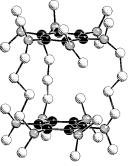

 |
Combinatorial Micro-Electrochemistry
The combinatorial synthesis of organic compound libraries and the
analytical characterization of the library elements are important in
life and material sciences.
Here, we explore the application of electrochemical techniques in
combinatorial chemistry. The electric current passed through the
electrolyte induces oxidations or reductions. The resulting
reactive intermediates (ions, radicals, radical ions, compounds in unusual
oxidation states) can undergo follow-up reactions to the desired products.
If performed under control of the electrode potential, electrochemical
reactions occur with high selectivity. Furthermore, the
redox reactions at the electrode do not require the use of oxidants
or reductants which are often metal salts. Thus, the amount of waste
produced in the reaction can be reduced.
However, in combinatorial chemistry, the use of electrochemical
techniques has been limited to special analytical applications
("electrode arrays") and the less selective galvanostatic electrolysis.
In this project, a new instrument, the CombiSECM,
has been constructed, tested and used.
It is based on scanning electrochemical microscope (SECM) technology, and
localizes electrochemical synthesis and analysis in a manner
which is compatible with combinatorial electrochemistry.
The electrochemical reactions are conducted in the wells of microtiter
plates at so-called electrode bundles. The reaction volume is about
200 µl. Up to 96 syntheses or analyses can be performed in a
conventional plate. Either new compounds are generated in small amounts
within the wells or compounds dissolved in the small electrolyte
volume are analyzed by cyclic voltammetry. In the analytical
application, the experiment runs considerably faster as compared to
conventional work.
During electro synthesis, the experimental progress is monitored on-line by steady-state microelectrode voltammetry. Final products are detected by
techniques such as GC-MS or HPLC-MS.
We use the CombiSECM among others for the synthesis of 1,2,4-triazoles, iminoquinols, and triazolpyridinium salts. Reductive electrolyses of
electron-deficient alkenes (electro hydrodimerization) and allyl halides in
the presence of α,β-unsaturated esters lead to "electrolysis
screening", a method to deduce reaction mechanisms from the results of
combinatorial electro synthetic experiments.
Cyclic voltammetric analyses of ruthenium complexes with catalytic activity
were performed. Not only non-aqueous organic electrolytes are employed, but also ionic liquids.
This is a co-operative project between the groups of
Wolfgang Schuhmann, Bochum, Günter Jung, Tübingen, and this group.
Finally, the control of the instrument is currently reorganized as part of the
 EChem++
project in cooperation with EChem++
project in cooperation with
 Martin Bogdan
(Wilhelm-Schickhard-Institut für Informatik, Tübingen). Martin Bogdan
(Wilhelm-Schickhard-Institut für Informatik, Tübingen).
Coworkers in this project
Bernd Speiser, Carsten Tittel, Wolfgang Märkle, Matthias Vollmer, Markus Schwarz, Markus Sekler
and Maruthai Chandrasekaran (CECRI, Karaikudi, India).
We acknowledge funding of this project by the
Deutsche Forschungsgemeinschaft, Bonn -
Bad Godesberg, the DAAD, Bonn and the CSIR, New Delhi, India (DAAD/CSIR Exchange Program).
Oral presentations
M. Schwarz and B. Speiser at the  58th ISE Annual Meeting, Banff/CA, September 9 - 14, 2007 58th ISE Annual Meeting, Banff/CA, September 9 - 14, 2007
Publications from this project
Markus Sekler;
 Kombinatorische Elektrohydrodimerisierung von elektronenarmen Alkenen (2006) Kombinatorische Elektrohydrodimerisierung von elektronenarmen Alkenen (2006)
Markus Schwarz;
 Kombinatorische Elektrosynthese in ionischen Flüssigkeiten (2005) Kombinatorische Elektrosynthese in ionischen Flüssigkeiten (2005)
W. Märkle, B. Speiser, C. Tittel and M. Vollmer, Electrochim. Acta, 50,
2753-2762 (2005); Combinatorial Micro Electrochemistry. Part 1. Automated Micro Electrosynthesis
of Iminoquinol Ether and [1,2,4]Triazolo[4,3-a]pyridinium Perchlorate Collections in the Wells
of Microtiter Plates.
T. Erichsen, S. Reiter, W. Märkle, C. Tittel, V. Ryabova, E.M. Bonsen, G. Jung, B. Speiser und
W. Schuhmann, Rev. Sci. Instrum., 76, 062204-1-062204-11 (2005); Combinatorial Micro
Electrochemistry. Part 2. Development and Evaluation of an Electrochemical Robotic System.
W. Märkle und B. Speiser, Electrochim. Acta, 50, 4916-4925 (2005);
Combinatorial Microelectrochemistry. Part 3. On-Line Monitoring of Electrolyses by Steady-State
Cyclic Voltammetry at Microelectrodes.
E. Lindner, Z.-L. Lu, H.A. Mayer, B. Speiser, C. Tittel und I. Warad,
Electrochem. Commun., 7, 1013 - 1020 (2005); Combinatorial Micro
Electrochemistry. Part 4. Cyclic Voltammetric Redox Screening of Homogeneous Ruthenium(II)
Hydrogenation Catalysts (also: Electrochemistry of Transition Metal Complexes, Part 12).
Wolfgang Märkle;
 Kombinatorische
Elektrosynthese - Geräteoptimierung, Reaktionsverfolgung und
Anwendung auf Heterocyclensynthesen (2004) Kombinatorische
Elektrosynthese - Geräteoptimierung, Reaktionsverfolgung und
Anwendung auf Heterocyclensynthesen (2004)
Matthias Vollmer; Kombinatorische elektrochemische Synthese von Iminochinolderivaten (2004)
|


